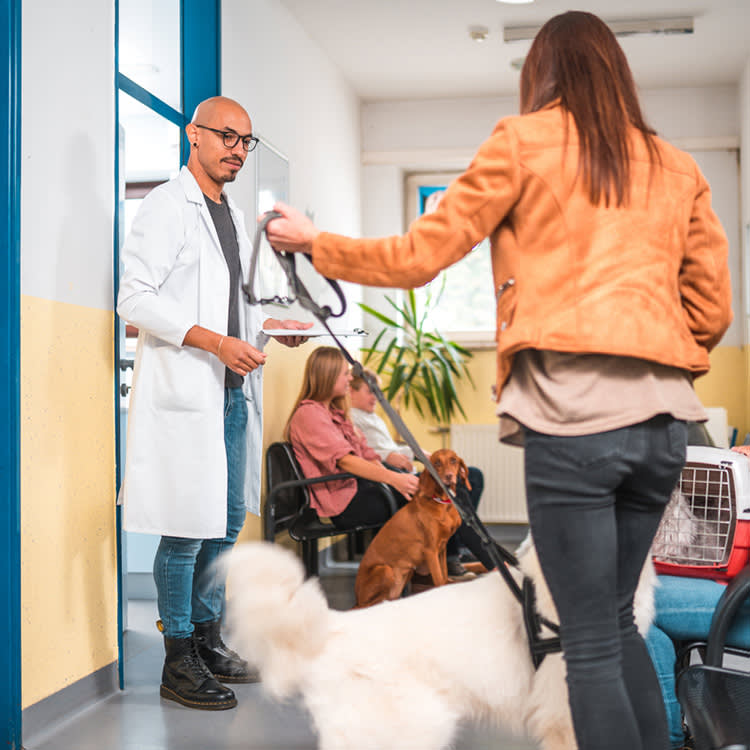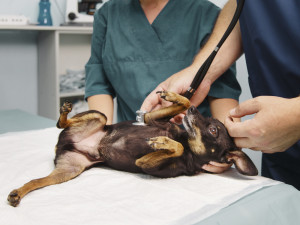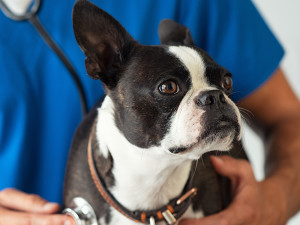I Freaked Out at the Emergency Vet So You Don’t Have To
What to expect from and how to make the most of a trip to the ER.

share article
It started with a few late-night whimpers. My dog, Banshee, has never been one to shy away from the dramatics, so I initially thought nothing of it. This is a dog who regularly fakes a limp after destroying my personal belongings so I’ll conjure up some feelings of sympathy for her. Needless to say, I wasn’t too worried. That is, until I caught the sight of some bloodopens in a new tab in her urine — then it was full-on anxiety, freak-out time. I did what any rational dog parent would do and contacted my friendly neighborhood search engine. The results were terrifying, with possible causes being canceropens in a new tab, kidney stones, or an enlarged prostate. (I may have forgotten to add “dog” to the search bar.)
After composing myself, I made the actually rational decision to take my girl to the emergency vet. The entire ordeal was a lot less scary than it might have originally seemed, though I could have avoided a couple of panic attacks if I knew then what I do now. Here, I attempt to pass along those lessons, so you’ll have a more relaxing experience if you’re ever faced with a similarly terrifying dilemma.
Many ER visits are not for dramatic reasons.
Look, I’m old enough to have watched ER when it was still on TV, so as I was driving to my local Veterinary Emergency Groupopens in a new tab in Hoboken, New Jersey, it seemed the doctors would have much more pressing concerns than what evidently was a UTI. But when I arrived, it soon became clear that the Jersey pet-doctor iteration of George Clooney was not often occupied by the drama of violent attacks or nasty car accidents. Actually, most people bring their animals to an emergency vet for reasons similar to mine.
“ER vets treat anything from vomitingopens in a new tab and diarrheaopens in a new tab to wound repairs from injuries to critically ill pets with complex diseases. Most commonly, we see pets experiencing some sort of gastrointestinal upset — usually seen by pet parents as vomiting and diarrhea,” explains Dr. Monica Sterk, Area Medical Director at the Veterinary Emergency Group.
Other than being open well after the sun goes down, emergency vet offices are just like that of primary vets. Pet parents will enter and find someone at the front desk offering intake paperwork. There’s a waiting room, exam rooms, and treatment areas — essentially, all of the basics. Overall, the experience may feel extra stressful but the actual environment is pretty...average.
Be aware of how your pet might react to the stress of the situation — and of the cost.
OK, but what if your dog requires special treatment or arrangements? That’s a great question, phantom inquirer — and one I also faced. Banshee is very animal reactive. If you find yourself in a similar situation, channel your inner marriage counselor and remember that communication is key. As Dr. Sterk explains, “If you know that your pet is reactive to other pets or people, it’s best if you alert the veterinary team before arriving and remind them as soon as you arrive. Sometimes, calling from the parking lot can be helpful so that the team can work quickly to create a plan to get you and your pet to a private area safely.”
In terms of pricing, you should expect to pay a bit more than you would for a normally scheduled vet appointment. Dr. Sterk notes that while there is no typical service range for either ER vets or primary ones, the price of immediate diagnostics like bloodwork or X-rays can cost slightly more at the ER, versus a general practice when the results are not needed as quickly. Of course, you should receive a breakdown of fees before agreeing to anything.
It’s important to remain calm — even if you don’t feel that way.
Despite the emotional chaos these scenarios can inspire, it’s crucial to keep a level head — and not only for your mental health and blood pressure, but for the well-being of your pet. “Although it can be stressful to be at the pet ER, it’s important to stay calm and remind yourself that you’ve done the right thing by bringing your pet to a place where they can get the help they need. Stress can often be sensed and reflected onto our pets, similarly to how it is on children,” Dr. Sterk adds. Also, if you’re initially unsure of whether or not to take your pet to the ER, she recommends calling ahead first and speaking with a professional, adding that it’s always better to be safe than sorry.
Ultimately, other than some additional costs and unpredictable wait times, visiting an emergency vet probably won’t be much different from taking a trip to a primary. Dr. Sterk’s last kernel of advice is essentially to trust the pros and the process; it’s an effective system for a reason. “Remember that you and your veterinarian are on the same team and want to do what’s best for your pet,” she says.

Sean Zucker
Sean Zucker is a writer whose work has been featured in Points In Case, The Daily Drunk, Posty, and WellWell. He has an adopted Pit Bull named Banshee whose work has been featured on the kitchen floor and whose behavioral issues rival his own.
Related articles
![A woman in a bright yellow-orange sweater holding a striped kitten in one hand and a credit card in the other while using her laptop in front of her]() opens in a new tab
opens in a new tabCan’t Pay Your Pet’s Vet Bills? These Orgs Can Help
When the bills rack up, these resources have your back.
![French bulldog being examined at the vet via stethoscope]() opens in a new tab
opens in a new tab9 Tips for Saving Money at the Vet
Ways to lower your bill — without compromising your pet’s health.
![French bulldog puppy looking scared at vet]() opens in a new tab
opens in a new tab10 Things to Ask at Your First Vet Visit
There are no stupid questions — well, when it comes to your dog’s health.
![black scruffy dog wearing cone recovering from spay surgery]() opens in a new tab
opens in a new tabEverything You Need to Know About Spaying and Neutering Your Dog
A vet’s take on why it’s a smart choice. Snip, snip!
![Dog laying on couch in the sun]() opens in a new tab
opens in a new tabSeizures Are the Stuff of Dog-Parent Nightmares
What you need to know about seizures and dogs (and canine epilepsy) so you’re prepared and your pup is cared for.
![bandaging dog's bleeding paw]() opens in a new tab
opens in a new tabHow to Care for Your Bleeding Dog
Don’t freak out—here’s what to do.








